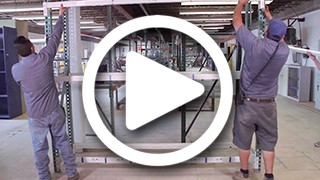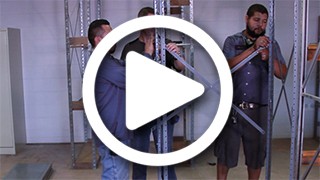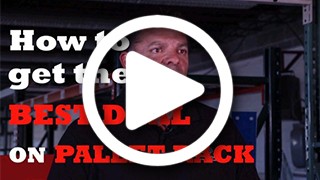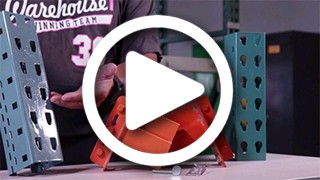Guide to Warehouse Aisle Widths
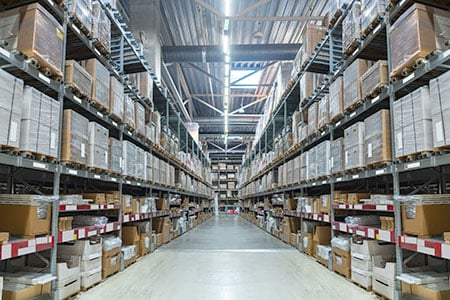 When determining the ideal warehouse layout or design, there are many needs and priorities to consider: the desire for maximum storage space, seamless workflows, and worker safety, to name a few. Aisle widths play into all these concerns and ultimately determine how employees and equipment navigate warehouses.
When determining the ideal warehouse layout or design, there are many needs and priorities to consider: the desire for maximum storage space, seamless workflows, and worker safety, to name a few. Aisle widths play into all these concerns and ultimately determine how employees and equipment navigate warehouses.
A thorough understanding of aisle widths should underscore any warehouse design effort, especially for businesses with large equipment or specific pallet racking needs. Aisle widths are complicated, however, and many enterprises fail to account for their unique goals and processes when deciding how wide warehouse aisles should be.
Determining the right width can be difficult in part because so many considerations play into this calculation. There is no one 'ideal' width, but rather, different approaches for different situations. That being said, there are a few basic requirements to keep in mind, as well as best practices to promote safety — especially when forklifts are involved.
To help, we've provided a thorough guide to warehouse aisle widths: what is normal, what is preferable, and how to allocate space to promote a safe facility without compromising too much on storage density.
Factors Influencing Aisle Width
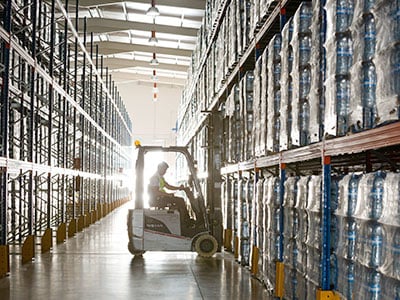 While no one aisle width strategy is appropriate in every situation, these dimensions are typically determined based on the facility's square footage and the size of relevant equipment. This means taking inventory of all current equipment that navigates warehouse aisles. Forklifts are typically central to this effort, although pallet jacks and other sizable equipment may also come into play.
While no one aisle width strategy is appropriate in every situation, these dimensions are typically determined based on the facility's square footage and the size of relevant equipment. This means taking inventory of all current equipment that navigates warehouse aisles. Forklifts are typically central to this effort, although pallet jacks and other sizable equipment may also come into play.
Forklifts vary significantly in size, but it's common practice to focus on the largest forklift in the warehouse to determine how wide aisles need to be. The 'average' forklift will span anywhere from 4 to 7 feet in width, although some smaller forklifts barely exceed 3 feet in width. Typically, a forklift will be a minimum of 8 feet long, but many facilities need to account for 10-foot forklifts.
Preferred aisle dimensions depend not only on the size of the forklift but also how they actually operate. For example, standup single-reach or deep-reach forklifts function a lot differently from their seated, counterbalanced cousins. Standup options work well with aisles spanning just 10 feet, while seated equipment may call for at least 12 feet to navigate effectively.
The forklift's height has less of an influence on aisle width but may still warrant consideration if it will impact access points such as doors or gates. Turning radius is also worth noting; in general, long forklifts also have a large turning radius and require more space to maneuver.
In some situations, pallet jack dimensions may be more relevant. These are typically between 18 and 24 inches wide, and 48 to 60 inches long. These are better suited to narrow aisles, where safe or effective forklift operation may not be realistic.
How to Calculate Optimal Aisle Width for Your Warehouse
There is no one ideal aisle width that will work for all warehouses. However, a few calculations can reveal what constitutes 'too small' for a particular facility. Follow these steps to get started:
 Step 1: Calculate space for the largest equipment. Begin by identifying what, exactly, occupies the most space in your warehouse. Chances are, heavy-duty forklifts will attract the most attention. Determine their dimensions and be prepared to develop warehouse aisle strategies accordingly.
Step 1: Calculate space for the largest equipment. Begin by identifying what, exactly, occupies the most space in your warehouse. Chances are, heavy-duty forklifts will attract the most attention. Determine their dimensions and be prepared to develop warehouse aisle strategies accordingly.- Step 2: Factor in additional space for ease of operation. While large equipment provides a valuable starting point, additional space will be needed to ensure that this equipment can be operated safely and effectively. This is especially important if the largest identified forklift has a significant turning radius.
- Step 3: Accommodate overhang or protrusion from shelves. What initially seems like a wide aisle may prove less-than-ideal once shelving concerns are added to the mix. These issues can often be avoided simply by selecting pallet racks that align with the sizes and shapes of stored products. Palletization training may also help. Still, it's common practice to add between 3 and 6 inches to aisle width for an overhang 'just in case.'
- Step 4: Tailor calculations based on unique layouts or other unexpected features. Modifications in aisle width often stem from concerns related to overhang, but other issues can also come into play. Transit aisles and picking areas should be top of mind, but workstations, mezzanines, and other features may also influence aisle dimensions or layouts.
Aisle Width and Warehouse Efficiency
Aisle width has a huge impact on warehouse efficiency. Simply put, narrow aisles are difficult to navigate, particularly when using sizable forklifts. Wider aisles provide more room for maneuvering, so forklifts can more easily get where they need to go without running the risk of damaging products or pallet racks.
In a warehouse with narrow aisles, storage capacity can easily be maximized — but accessing these stored items could prove difficult. Forklifts may need to move slowly to avoid contact with pallet racks and, once items have been loaded, they may still be difficult to move.
Impact of Storage Systems and Racking
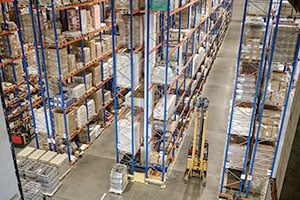 As we've touched on, pallet racking can have a huge impact on aisle width. If nothing else, strategically selected pallet racks will reduce the potential for overhang. The racks themselves, however, also take up space and could potentially make a seemingly sizable aisle feel a lot smaller.
As we've touched on, pallet racking can have a huge impact on aisle width. If nothing else, strategically selected pallet racks will reduce the potential for overhang. The racks themselves, however, also take up space and could potentially make a seemingly sizable aisle feel a lot smaller.
A lot depends on how these pallet racks are accessed. Facilities with limited space, for example, often rely on drive-in pallet racks to maximize storage space. Cantilever racks, however, are more likely to occupy valuable aisle space, as are the bulky or unusually shaped products they are meant to store.
The ideal aisle width and pallet system will accommodate two distinct priorities: storage density and accessibility. There is no perfect way to achieve both and, on occasion, one of these priorities may need to be compromised to some extent.
Important Safety Considerations
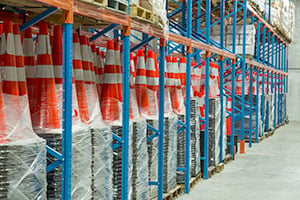 Safety standards from the Occupational Safety and Health Administration (OSHA) should play heavily into aisle sizing and design. OSHA recommendations indicate that aisles should be at least three feet wider than warehousing equipment. OSHA recommendations also cite a minimum aisle width of 4 feet, although most operations will require far wider aisles.
Safety standards from the Occupational Safety and Health Administration (OSHA) should play heavily into aisle sizing and design. OSHA recommendations indicate that aisles should be at least three feet wider than warehousing equipment. OSHA recommendations also cite a minimum aisle width of 4 feet, although most operations will require far wider aisles.
In general, the goal should be to create a safe space in which both people and equipment can maneuver without fear of injury or damaged products. Long-term strain must also be considered; even if collisions are avoided, some setups may force workers to hold their heads in unnatural, uncomfortable, and potentially dangerous positions for long periods of time.
Best Practices in Warehouse Aisle Width Management
Establishing the right aisle width is only the beginning. Other solutions must be implemented to ensure that any space, no matter how wide, is properly utilized. Follow these best practices to keep aisles safe without compromising workflows:
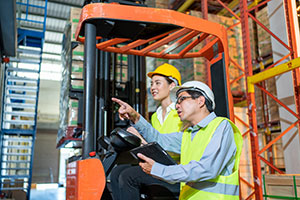 Ongoing training. Regardless of aisle width, staff members need to understand how to navigate these spaces safely and efficiently. This is best achieved through in-depth training, which occurs not only during the onboarding process, but also, periodically over time so that workers remain up to date.
Ongoing training. Regardless of aisle width, staff members need to understand how to navigate these spaces safely and efficiently. This is best achieved through in-depth training, which occurs not only during the onboarding process, but also, periodically over time so that workers remain up to date.- Signage. Training can make a world of difference, but visual reminders are also essential. Therein lies the value of signage, which instantly reminds workers how they should navigate these spaces. Signs should designate forklift aisles, work areas (such as work cells), pedestrian lanes, and especially crossing areas.
- Review aisle widths and consider changes. Aisle dimensions that worked wonderfully in the past may no longer be relevant. As pallets or equipment change, aisles may need to as well. Monitor aisle conditions and relevant metrics regularly to determine whether current strategies need to be adjusted.
How Warehouse1 Can Help With Aisle Design
Still struggling to find the right width for your warehouse? As you assess your current equipment and seek out the ideal setup, look to Warehouse1 for extra insight. We can help you determine the ideal aisle width that takes your facility's unique needs and dimensions into account. Our warehouse design services aim to optimize pallet rack placement and improve your facility's workflow. Reach out today to learn more.
